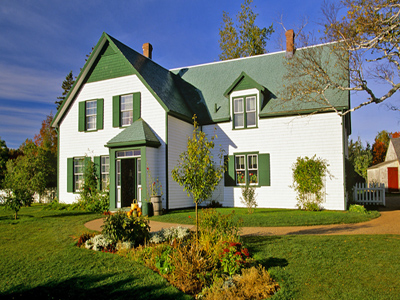L.M. Montgomery's Cavendish National Historic Site of Canada
Prince Edward Island National Park of Canada, Prince Edward Island

Showing its modest scale, vernacular design
© Parks Canada Agency / Agence Parcs Canada.
Address :
Route 6, Cavendish, Prince Edward Island National Park of Canada, Prince Edward Island
Recognition Statute:
Historic Sites and Monuments Act (R.S.C., 1985, c. H-4)
Designation Date:
2004-10-12
Event, Person, Organization:
Other Name(s):
-
L.M. Montgomery's Cavendish
(Designation Name)
-
Green Gables House
(Other Name)
Research Report Number:
1999-005, 2003-044
Plaque(s)
Existing plaque: Route 6, Prince Edward Island National Park of Canada, Prince Edward Island
Bringing together the real and imaginary worlds of Lucy Maud Montgomery ( 1874 1942), this landscape is intimately associated with her formative years and prolific career as a writer. To the northeast are the ruins of the author's home from 1876 to 1911, the Cavendish farmhouse where she lived with her maternal grandparents, Lucy and Alexander Macneill, following her mother's illness and death. It was here that Montgomery wrote her most famous novel, Anne of Green Gables (1908), and her beloved The Story Girl (1911), as well as numerous other stories and poems. She drew inspiration for much of her writing from these surroundings, including the house to the west, now known as Green Gables, and places such as the Haunted Wood and Lover's Lane, which are cherished by her fictional character Anne Shirley. This landscape of rolling farm fields, woodlands, and winding paths provided Montgomery with great joy in her early years, and remained dear to her throughout her life. This setting has also held special meaning for generations of her admirers, who continue to visit and reflect upon the life and work of this well-loved, internationally renowned author.
Description of Historic Place
L.M. Montgomery’s Cavendish National Historic Site is a cultural landscape that embraces the landscape near Cavendish, Prince Edward Island, that author L. M. Montgomery knew so well and made famous in her “Anne of Green Gables” books. The designated area includes the Green Gables house, Montgomery’s Cavendish home, and several landscape features such as the Haunted Wood Trail, Balsam Hollow Trail and Lover’s Lane, dear to Montgomery and familiar to her readers.
Heritage Value
L.M. Montgomery’s Cavendish was designated a National Historic Site because: it is intimately associated with L.M. Montgomery’s formative years and early productive career; it establishes Montgomery in time and in place in her world of Cavendish, and reveals the natural surroundings and circumstances in her life which influenced the setting and story of her most famous novel, "Anne of Green Gables", and its sequel, "Anne of Avonlea"; many places in this landscape of rolling farm fields and wooded groves and paths were dear to her and have continued to hold special meaning for generations of her admirers.
L.M. Montgomery’s Cavendish National Historic Site embraces two segments of a cultural landscape intimately associated with the author: one is the farm of Montgomery’s maternal grandparents where she lived for the first 37 years of her life. This farmscape incorporates the ruins of the house and farm buildings that existed in Montgomery’s time, as well as the wooded groves and pathways described in her stories. The second area encompasses Green Gables, the neighbouring farmstead which features in Montgomery’s most famous novel, "Anne of Green Gables" published in 1908, and includes the house in its natural setting with surroundings that inspired both her imagination and her fiction including the Haunted Wood Trail, the schoolhouse, Lover’s Lane, the Balsam Hollow Trail and the babbling brook. Together these landscapes evoke both Montgomery’s real life and the fictional world she created.
The heritage value of L.M. Montgomery’s Cavendish National Historic Site resides in its evocation of L.M. Montgomery’s world – both real and imaginary – at the time of her most famous accomplishments. Its value lies in the physical properties of these two landscapes that both inspired Montgomery’s fiction, and give her fictional world a basis in reality. They include the sites and settings, buildings and landscape features that provided a backdrop for both Montgomery’s life and her literary work.
Source: Historic Sites and Monuments Board of Canada, Minutes, Spring 1999, December 2003.
Character-Defining Elements
Key features contributing to the heritage value of this site include: the integrity of the two areas comprising the cultural landscape as a reflection of Montgomery’s personal and literary worlds; their location in rural Prince Edward Island;
The Montgomery Homestead evidence of the extent and siting of the former house in its footprint as defined by the surviving foundation; its setting among wooded groves, pathways and rolling agricultural fields;
Green Gables its illustration of the fictional Green Gables of Anne, notably its modest scale, vernacular design, wood construction and sheathing, gabled roofline, use of the colour green, and interior layout; the walking trail to the east of the house in its features that illustrate Montgomery’s fictional Haunted Wood Trail and to the south of the house in its features that illustrate Montgomery’s fictional description of Lover’s Lane, Balsam Hollow Trail and the babbling brook; the continued ambience and well being of these features, particularly as landscape features are supported by the presence of specific varieties of vegetation and undisturbed spatial volumes.